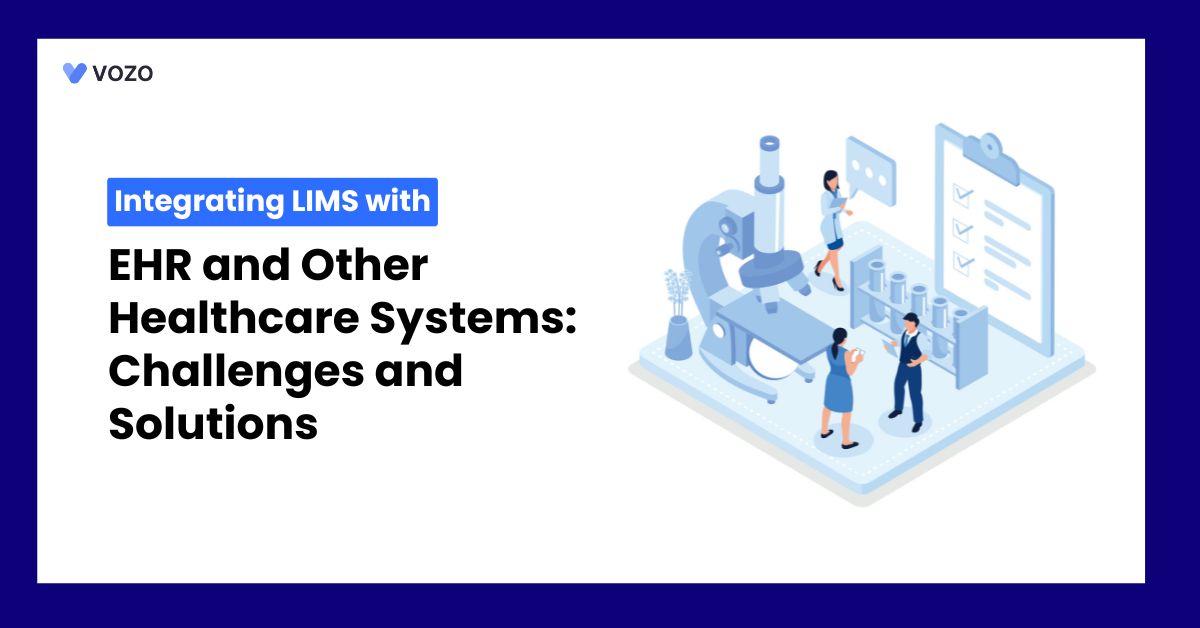Integrating LIMS with EHR and Other Healthcare Systems: Challenges and Solutions
Integrating LIMS with EHR and other healthcare systems improves data exchange and patient care. This integration, however, presents challenges such as system compatibility issues, data security hazards, and compliance with healthcare legislation. Without effective integration, labs and providers may encounter disconnected systems.
This can result in errors, delays, and inefficiencies in laboratory reporting. However, these challenges can be effectively solved with the right strategies. In this blog, we discussed the key challenges of LIMS and EHR integration and solutions to address them.
What is a Laboratory Information Management System
A Laboratory Information Management System is software for managing lab operations. It helps laboratories to track samples, organize data, and automate workflows. Many industries use LIMS, including healthcare, pharmaceuticals, and environmental testing. LIMS allows to:
- Tracks Samples – It records where samples come from and their details. This helps labs monitor testing progress and store accurate information.
- Manages Data – It securely saves test results and organizes lab information. This ensures quick access to records whenever they are needed.
- Automates Workflows – It reduces manual tasks and improves efficiency in labs. This minimizes errors and speeds up laboratory processes significantly.
- Ensures Compliance – It helps labs meet strict industry regulations and guidelines. This includes standards like HIPAA, CLIA, and FDA compliance requirements.
- Integrates with Systems – It connects with lab instruments and other essential software. This allows seamless data sharing with Electronic Health Records.
Challenges in LIMS and EHR Integration
1. Interoperability and Data Compatibility Issues
Integrating LIMS with EHR systems is often a complex process. Different healthcare providers and labs use separate systems for managing data. Because of this, their software may not integrate.
- LIMS and EHRs store data using unique formats and structures. As a result, transferring information between them can become a difficult task.
- Most healthcare systems follow HL7 or FHIR for data exchange. However, many LIMS platforms rely on their custom formats. This mismatch creates barriers when trying to share patient information.
- Lab results must be structured correctly before reaching the EHR system. If not, important information can be lost or misunderstood easily.
2. Standardization and data mapping difficulties
Connecting LIMS with EHR systems requires clear rules for organizing data. However, different systems use unique formats that make sharing information difficult. This might result in a mismatch of patient records correctly.
- Most healthcare systems use HL7 or FHIR for data exchange. However, many LIMS platforms follow their formats and structures. This difference makes it harder for both systems to communicate properly.
- Labs and hospitals may use different names for the same test. As a result, the same result may appear with different labels.
- Each test result must connect to the right EHR section. If not, the information may appear in the wrong field. This issue can create confusion and lead to medical errors.
- If data is not mapped correctly, some details may disappear. Missing information can cause delays in diagnosis and medical treatment.
3. High implementation costs and resource constraints
Integrating EHR and LIMS requires a large budget and careful planning. However, many healthcare providers have limited funds for expensive integration projects.
Organizations must purchase software, hardware, and integration tools before starting. In addition, they need extra funds for security and customization. These aspects make small healthcare facilities struggle with financial limitations.
After integration, regular updates and security improvements are always necessary. However, these updates require technical support and additional financial resources. As a result, long-term expenses can become difficult to manage. Many healthcare organizations have small IT teams with multiple responsibilities. So, they may lack experts for handling complex integrations.
The full integration process can take several months to complete. However, unexpected delays may arise due to technical problems or staffing shortages. Daily operations may slow down due to this delay.
4. Data security and privacy concerns
Integrating LIMS with EHR systems improves efficiency in healthcare operations. However, it also creates serious risks related to data security. Protecting sensitive patient information is essential for healthcare providers. Here are some of the concerns in data security and privacy:
- When LIMS and EHR systems share data, security risks increase. Hackers can steal patient records if proper safeguards are missing.
- Without strict controls, sensitive records may be accessed by unauthorized individuals. This can lead to data misuse, fraud, or identity theft.
- Healthcare organizations must follow privacy laws like HIPAA and GDPR. Non-compliance can result in legal penalties and damaged reputation.
- Data must be encrypted when transferred between integrated systems. Otherwise, cybercriminals may intercept and manipulate critical patient information.
Related: The Biggest Healthcare IT Challenges & How Vozo EHR Integration Solves Them
Solutions to Overcome Integration Challenges
1. Using HL7 and FHIR standards for interoperability
HL7 v2 structures lab orders and results for consistent data exchange. FHIR APIs provide modern web-based access to medical records instantly. This way, Healthcare providers can retrieve lab results without delays. This automation reduces manual work and prevents common data entry mistakes.
Also, accurate information ensures healthcare providers receive reliable test results. Otherwise, errors in reports may lead to incorrect patient treatments. HL7 and FHIR follow strict security rules like HIPAA compliance. Therefore, labs and clinics can share information while protecting patient privacy.
2. Implementing APIs for seamless data exchange
APIs act as a secure bridge between both healthcare systems. They allow real-time communication between LIMS and EHR without manual input. This automated process improves efficiency and reduces human errors significantly. Moreover, APIs ensure secure data transfer while maintaining system integrity.
3. Ensuring strong cybersecurity measures and compliance
To protect data, healthcare organizations must use strong security methods.
- Encryption ensures that only authorized users can read or access data. This prevents hackers from stealing sensitive patient and lab information.
- Access control limits system entry to approved staff members only. This helps prevent unauthorized individuals from viewing or modifying records. In addition, multi-factor authentication adds extra layers of verification.
- MFA requires users to enter passwords and additional security codes. This makes hacking attempts much harder for cybercriminals to succeed. Also, security audits help detect weaknesses before threats become major issues.
Regular system checks ensure vulnerabilities are found and fixed quickly.
Moreover, data backups protect important files from accidental deletion or cyberattacks. This ensures critical patient and lab information is never lost.
4. Providing proper training and support for users
Many users struggle to adapt to new technology easily. Without proper training, mistakes can happen and cause workflow disruptions. That’s why training and support are essential for smooth adoption.
- Different users need training that fits their job roles. Lab technicians require detailed guidance on handling test results properly. Meanwhile, providers must learn how to access lab reports quickly. Administrators also need training to manage system access and settings.
- Practical training helps users understand the system better and faster. Interactive sessions allow them to practice real tasks in a safe setting.
- Users need quick assistance when they face technical difficulties. A dedicated help desk ensures immediate solutions for unexpected issues. Online guides and tutorials also provide step-by-step troubleshooting tips. Live chat support can answer questions instantly and prevent workflow delays.
Vozo EHR with Integrated Labs
From managing and organizing patient health records digitally to reducing medical errors, the electronic health records system significantly empowers providers to improve healthcare quality.
Vozo EHR can be your first option if you’re looking for the greatest EHR system for your healthcare organization. Our all-inclusive EHR system simplifies and bears all the duties so you may concentrate more on patient care.
- Vozo Cloud EHR’s cost-effective cloud subscription benefits all levels of practice.
- Our feature-rich EHR helps you rectify mistakes efficiently and speed up the process.
- Vozo Specialty EHR resonates with specialty practice needs and requirements.
- Our expert technical team got you covered 24/7 if any needs arise.
- Our EHR System continues to scale as your healthcare practice grows to improve the user experience.
The Vozo Customized EHR solution benefits your healthcare practices, increasing productivity and cost savings by streamlining the administrative process, enhancing workflow efficiency, lowering mistake proneness, managing all patient records in one location, and more.
Our specialty-specific tools like scheduling, patient portals, lab integration, cloud hosting, and more meet your healthcare practice’s specific needs and requirements.
“Embrace Vozo EHR to Reduce Your Burdens and Enhance Patient Care”
About the author

With more than 4 years of experience in the dynamic healthcare technology landscape, Sid specializes in crafting compelling content on topics including EHR/EMR, patient portals, healthcare automation, remote patient monitoring, and health information exchange. His expertise lies in translating cutting-edge innovations and intricate topics into engaging narratives that resonate with diverse audiences.













